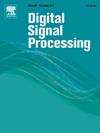Reversible data hiding based on pixel value similarity ordering and ordered collection
IF 2.9
3区 工程技术
Q2 ENGINEERING, ELECTRICAL & ELECTRONIC
引用次数: 0
Abstract
In pixel value ordering (PVO)-based reversible data hiding (RDH), a smoother pixel sequence enhances embedding capacity and visual quality. Existing global PVO-based RDH methods use pixel complexity values for secondary ordering, which inaccurately reflect pixel value size, reducing sequence smoothness. This study proposes a pixel value similarity (PVS) ordering method to improve secondary pixel ordering. A value feature set is constructed for each pixel, and pixel value similarity is calculated to place pixels with the closest PVS adjacently. Additionally, a pixel ordered collection (POC) strategy organizes pixels in subsequences to increase expanded prediction errors, boosting embedding capacity. Experimental results demonstrate that PVS ordering yields smoother pixel sequences, with lower standard deviation (SD) and sum of absolute differences (SAD) compared to complexity-based methods. The proposed PVS and POC strategies enhance marked image quality, on the Kodak image dataset achieving an average peak signal-to-noise ratio (PSNR) of 61.38 dB with 20,000 bits embedding capacity.
基于像素值相似排序和有序收集的可逆数据隐藏
在基于像素值排序(PVO)的可逆数据隐藏(RDH)中,平滑的像素序列提高了嵌入容量和视觉质量。现有的基于全局pvo的RDH方法使用像素复杂度值进行二次排序,不能准确反映像素值的大小,降低了序列的平滑性。本研究提出一种像素值相似度排序方法来改善二次像素排序。为每个像素构建一个值特征集,计算像素值相似度,将像素与最接近的PVS相邻放置。此外,像素有序收集(POC)策略按子序列组织像素,以增加扩展预测误差,提高嵌入容量。实验结果表明,与基于复杂度的方法相比,PVS排序产生的像素序列更平滑,具有更低的标准差(SD)和绝对差和(SAD)。所提出的PVS和POC策略提高了显著的图像质量,在柯达图像数据集上实现了平均峰值信噪比(PSNR)为61.38 dB,嵌入容量为20,000位。
本文章由计算机程序翻译,如有差异,请以英文原文为准。
求助全文
约1分钟内获得全文
求助全文
来源期刊

Digital Signal Processing
工程技术-工程:电子与电气
CiteScore
5.30
自引率
17.20%
发文量
435
审稿时长
66 days
期刊介绍:
Digital Signal Processing: A Review Journal is one of the oldest and most established journals in the field of signal processing yet it aims to be the most innovative. The Journal invites top quality research articles at the frontiers of research in all aspects of signal processing. Our objective is to provide a platform for the publication of ground-breaking research in signal processing with both academic and industrial appeal.
The journal has a special emphasis on statistical signal processing methodology such as Bayesian signal processing, and encourages articles on emerging applications of signal processing such as:
• big data• machine learning• internet of things• information security• systems biology and computational biology,• financial time series analysis,• autonomous vehicles,• quantum computing,• neuromorphic engineering,• human-computer interaction and intelligent user interfaces,• environmental signal processing,• geophysical signal processing including seismic signal processing,• chemioinformatics and bioinformatics,• audio, visual and performance arts,• disaster management and prevention,• renewable energy,
 求助内容:
求助内容: 应助结果提醒方式:
应助结果提醒方式:


